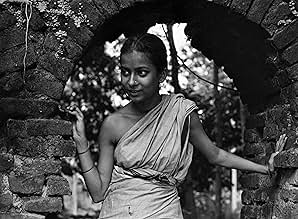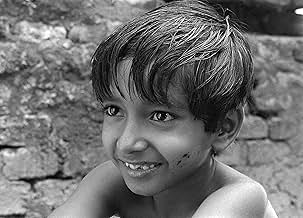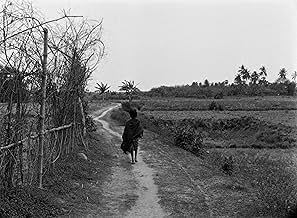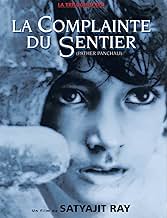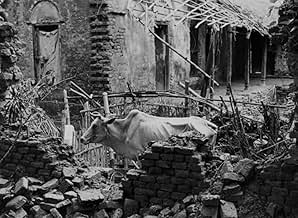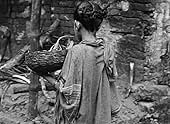AVALIAÇÃO DA IMDb
8,2/10
41 mil
SUA AVALIAÇÃO
O padre Harihar Ray, sonhando com uma vida melhor para si e sua família, deixa sua aldeia rural de Bengala em busca de trabalho.O padre Harihar Ray, sonhando com uma vida melhor para si e sua família, deixa sua aldeia rural de Bengala em busca de trabalho.O padre Harihar Ray, sonhando com uma vida melhor para si e sua família, deixa sua aldeia rural de Bengala em busca de trabalho.
- Direção
- Roteiristas
- Artistas
- Indicado para 1 prêmio BAFTA
- 11 vitórias e 3 indicações no total
Kanu Bannerjee
- Harihar Ray
- (as Kanu Bandyopadhyay)
Karuna Bannerjee
- Sarbojaya Ray
- (as Karuna Bandopadhyay)
Subir Banerjee
- Apu Ray
- (as Subir Bandopadhyay)
Uma Das Gupta
- Durga
- (as Uma Dasgupta)
Runki Banerjee
- Little Durga
- (as Runki Bandopadhyay)
Haren Banerjee
- Chinibas, Sweet-seller
- (as Haren Bandyopadhyay)
Roma Ganguli
- Roma
- (as Rama Gangopadhyay)
Binoy Mukherjee
- Baidyanath Majumdar
- (as Binoy Mukhopadhyay)
- Direção
- Roteiristas
- Elenco e equipe completos
- Produção, bilheteria e muito mais no IMDbPro
Avaliações em destaque
10zetes
It is a little known fact that India produces more films per year than any other country. The reason that most people don't know that is because their films do not generally appeal to us, and we would see them as oddities suspended in their own culture. Possibly they'd be amusing or interesting to watch, but they would probably be hard to enjoy (to demonstrate the difference in taste, Roger Ebert attended an Indian film festival a year or two ago, and when he questioned its director what American film did the best business over there, he answered that the movie _Baby's Day Out_, which is basically like one of those Popeye cartoons where Sweet-Pea wanders through construction sights blindly, except extended to 90 minutes, had theaters packed in India all throughout its run; the film bombed completely in the US). Tastes differ. Humanity does not. This is proved to the utmost in Ray's masterful _Pather Panchali_.
This film has got to be the best ever made about, well, life in general. It reminded me a lot of a Chinese film, Zhang Yimou's _To Live_, which was good, but its situations finally seemed a bit contrived. _Pather Panchali_ feels as real as life itself. To be sure, it contains great moments of sadness, but, for the most part, it concentrates on the beauty of the world around us. One of the major characters is this ancient woman, maybe even in her nineties. She is hunched over, has no teeth, and has crooked eyes. But Ray makes her form beautiful. He often finds characters with exaggerated and odd features. And there is nothing more beautiful in this world than the love between members of a family, and Ray revels in this. The relationship between the brother and sister is heartstoppingly beautiful.
I could not say anything bad about this film. But there is one thing I would like to see: a DVD version of this film, and indeed of each of the films of the Apu Trilogy, and only Criterion could do this effectively, which is kind of disappointing, since I know a major film company already owns its rights and would probably never give them up without huge pay; a DVD version with scholarly commentary. Hindu symbology is present in a large quantity in this film, along with several Hindi ceremonies. Of course, I loved seeing this. I am not completely unfamiliar with the culture, so I was able to catch a little, but there is so much I don't know. A commentary track on a DVD would help me understand the film better, and thus love it even more.
This film has got to be the best ever made about, well, life in general. It reminded me a lot of a Chinese film, Zhang Yimou's _To Live_, which was good, but its situations finally seemed a bit contrived. _Pather Panchali_ feels as real as life itself. To be sure, it contains great moments of sadness, but, for the most part, it concentrates on the beauty of the world around us. One of the major characters is this ancient woman, maybe even in her nineties. She is hunched over, has no teeth, and has crooked eyes. But Ray makes her form beautiful. He often finds characters with exaggerated and odd features. And there is nothing more beautiful in this world than the love between members of a family, and Ray revels in this. The relationship between the brother and sister is heartstoppingly beautiful.
I could not say anything bad about this film. But there is one thing I would like to see: a DVD version of this film, and indeed of each of the films of the Apu Trilogy, and only Criterion could do this effectively, which is kind of disappointing, since I know a major film company already owns its rights and would probably never give them up without huge pay; a DVD version with scholarly commentary. Hindu symbology is present in a large quantity in this film, along with several Hindi ceremonies. Of course, I loved seeing this. I am not completely unfamiliar with the culture, so I was able to catch a little, but there is so much I don't know. A commentary track on a DVD would help me understand the film better, and thus love it even more.
I don't know how even 6.4% of the female voters could have given this movie a 2!!!!! This was Ray's first movie, but his economy of dialog, his synchronization and sympathy with India's rural life is incredible. So little said, yet so much! Apu and Durga following the sweetmeat seller, the scene where they run through a "kash" field....superb, the work of a real artist, a master. The film develops its characters and the atmosphere slowly and resolutely. The narrative builds up to a powerful climax. Ray had an ancient camera while shooting this movie, did it matter? No. His expression and technique was more than sound, although this was a maiden venture.
Some critics found(and still find, I might add) the film to be too slow. Satyajit Ray wrote about the slow pace - "The cinematic material dictated a style to me, a very slow rhythm determined by nature, the landscape, the country. The script had to retain some of the rambling quality of the novel because that in itself contained a clue to the authenticity: life in a poor Bengali village does ramble."
There you are, if you have not watched this movie, you'll probably missed the greatest movie made on Indian rural life. That's why Akira Kurosawa said of him:"To have not seen the films of Ray is to have lived in the world without ever having seen the moon and the sun"
Some critics found(and still find, I might add) the film to be too slow. Satyajit Ray wrote about the slow pace - "The cinematic material dictated a style to me, a very slow rhythm determined by nature, the landscape, the country. The script had to retain some of the rambling quality of the novel because that in itself contained a clue to the authenticity: life in a poor Bengali village does ramble."
There you are, if you have not watched this movie, you'll probably missed the greatest movie made on Indian rural life. That's why Akira Kurosawa said of him:"To have not seen the films of Ray is to have lived in the world without ever having seen the moon and the sun"
What a wonderful film. For those who have not watched any films from India or heard of Ray, I strongly recommend it. Full of sadness, hope, innocence, and despair, it is an emotionally evocative portrait of the life of an Indian family, their trials, and their courage and persistence throughout. They go on, not because they are exceptional, but because they must, because they are human.
Ray does a masterful job of capturing the simple joys of childhood, and the ambitions and dreams which make us all human, regardless of where we are. Simple scenes such as a disfigured elderly woman seated on a porch, singing of her approaching death, are very moving. I have never seen the basic elements of life treated with such an incisive yet soft touch as Ray has in this film. It is wonderful to watch in comparison to the broad writing strokes and vulgar generalities of most directing and writing today. At the risk of sounding trite, this is a film which is not merely entertainment or art, but one which reaches into your heart and makes a place for itself there. It belongs there.
Ray does a masterful job of capturing the simple joys of childhood, and the ambitions and dreams which make us all human, regardless of where we are. Simple scenes such as a disfigured elderly woman seated on a porch, singing of her approaching death, are very moving. I have never seen the basic elements of life treated with such an incisive yet soft touch as Ray has in this film. It is wonderful to watch in comparison to the broad writing strokes and vulgar generalities of most directing and writing today. At the risk of sounding trite, this is a film which is not merely entertainment or art, but one which reaches into your heart and makes a place for itself there. It belongs there.
There is this one scene in Satyajit Ray's Pather Panchali when the eruption of a conflict between Apu's family and a quarrelsome neighbour brought the film to a complete standstill (for me anyway). Those few characters' state of mind and their relationship dynamics at that point in time, was conveyed with such explosive intensity, I got gut punched drunk.
Pather Panchali boasts of suitably melodramatic yet highly intuitive performances. Its breath taking cinematography ranks alongside existential beauty this side of Malick heaven. The musical scoring, by the great Ravi Shankar, is identifiably Indian, yet universally sublime. Together, these myriad parts melded into a whole so grand in its social consciousness, so incisively intimate in its portrait of one family, I could do nothing but be slowly devoured like a most willing prey.
On 4th Oct 2003, I saw my all time favourite film, Tokyo Story. The feeling I got today from Pather Panchali, is as close as is possible from that fateful October day.
Pather Panchali is one of the best films I have ever seen. This will be a night to remember. Now on with the other two then.
Pather Panchali boasts of suitably melodramatic yet highly intuitive performances. Its breath taking cinematography ranks alongside existential beauty this side of Malick heaven. The musical scoring, by the great Ravi Shankar, is identifiably Indian, yet universally sublime. Together, these myriad parts melded into a whole so grand in its social consciousness, so incisively intimate in its portrait of one family, I could do nothing but be slowly devoured like a most willing prey.
On 4th Oct 2003, I saw my all time favourite film, Tokyo Story. The feeling I got today from Pather Panchali, is as close as is possible from that fateful October day.
Pather Panchali is one of the best films I have ever seen. This will be a night to remember. Now on with the other two then.
This is a tour de force around a family's quest for that better future amidst sheer poverty. The film's success is not limited only to realistic depiction of human condition in early 20th century Bengal, but it brings up the triumph of human spirit, love and affection in spite of utter struggle in the most poignant way that one may think. Anybody remotely connected with movie making should also watch APARAJITO AND APUR SANSAR, to complete the experience, and off course to understand the art and craft of cinematic expression from the Maestro. No doubt it ranks in top 100 movie list from Time magazine, not to speak of almost all Indian publications connected with films rate this one as THE MOVIE.
Você sabia?
- CuriosidadesHalfway through filming, Ray ran out of funds. The Government of West Bengal loaned him the rest, allowing him to complete the film. This loan is listed in public records at the time as "roads improvement", a nod to the film's translated title.
- Erros de gravaçãoAlthough the film is set in early 20th-century rural India (a time in which public health campaigns presumably did not exist), when Apu and Durga are shown hiding in the fields waiting to catch a glimpse of the train, a vaccination mark is clearly visible on the right arm of Uma Das Gupta, who portrays Durga.
- Versões alternativasThere is an Italian edition of this film on DVD, re-edited with the contribution of film historian Riccardo Cusin. This version is also available for streaming on some platforms.
- ConexõesFeatured in Century of Cinema: And the Show Goes On: Indian Chapter (1996)
Principais escolhas
Faça login para avaliar e ver a lista de recomendações personalizadas
- How long is Pather Panchali?Fornecido pela Alexa
Detalhes
- Data de lançamento
- País de origem
- Central de atendimento oficial
- Idioma
- Também conhecido como
- Pather Panchali
- Locações de filme
- Boral, West Bengal, Índia(entire movie)
- Empresa de produção
- Consulte mais créditos da empresa na IMDbPro
Bilheteria
- Faturamento bruto nos EUA e Canadá
- US$ 134.241
- Fim de semana de estreia nos EUA e Canadá
- US$ 16.064
- 10 de mai. de 2015
- Faturamento bruto mundial
- US$ 135.342
- Tempo de duração
- 2 h 5 min(125 min)
- Cor
- Proporção
- 1.37 : 1
Contribua para esta página
Sugerir uma alteração ou adicionar conteúdo ausente


